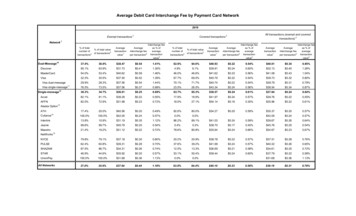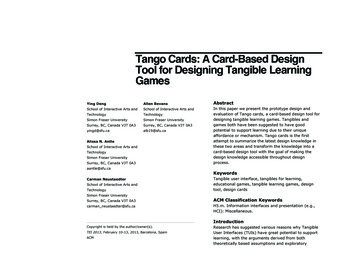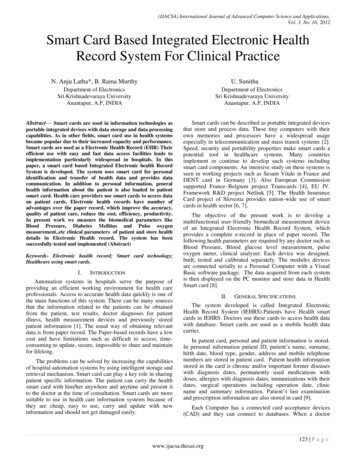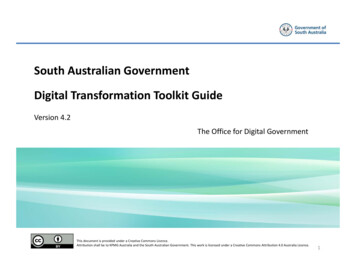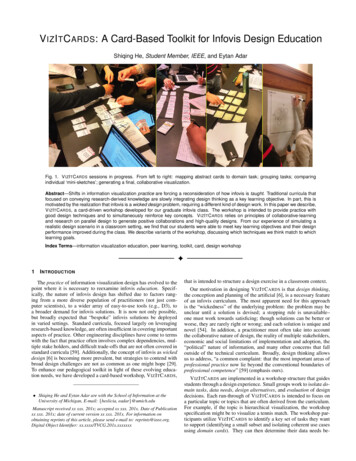
Transcription
V IZ I T C ARDS: A Card-Based Toolkit for Infovis Design EducationShiqing He, Student Member, IEEE, and Eytan AdarFig. 1. V IZ I T C ARDS sessions in progress. From left to right: mapping abstract cards to domain task; grouping tasks; comparingindividual ‘mini-sketches’; generating a final, collaborative visualization.Abstract—Shifts in information visualization practice are forcing a reconsideration of how infovis is taught. Traditional curricula thatfocused on conveying research-derived knowledge are slowly integrating design thinking as a key learning objective. In part, this ismotivated by the realization that infovis is a wicked design problem, requiring a different kind of design work. In this paper we describe,V IZ I T C ARDS, a card-driven workshop developed for our graduate infovis class. The workshop is intended to provide practice withgood design techniques and to simultaneously reinforce key concepts. V IZ I T C ARDS relies on principles of collaborative-learningand research on parallel design to generate positive collaborations and high-quality designs. From our experience of simulating arealistic design scenario in a classroom setting, we find that our students were able to meet key learning objectives and their designperformance improved during the class. We describe variants of the workshop, discussing which techniques we think match to whichlearning goals.Index Terms—information visualization education, peer learning, toolkit, card, design workshop1I NTRODUCTIONThe practice of information visualization design has evolved to thepoint where it is necessary to reexamine infovis education. Specifically, the nature of infovis design has shifted due to factors ranging from a more diverse population of practitioners (not just computer scientists), to a wider array of easy-to-use tools (e.g., D3), toa broader demand for infovis solutions. It is now not only possible,but broadly expected that “bespoke” infovis solutions be deployedin varied settings. Standard curricula, focused largely on leveragingresearch-based knowledge, are often insufficient in covering importantaspects of practice. Other engineering disciplines have come to termswith the fact that practice often involves complex dependencies, multiple stake holders, and difficult trade-offs that are not often covered instandard curricula [59]. Additionally, the concept of infovis as wickeddesign [6] is becoming more prevalent, but strategies to contend withbroad design challenges are not as common as one might hope [29].To enhance our pedagogical toolkit in light of these evolving education needs, we have developed a card-based workshop, V IZ I T C ARDS, Shiqing He and Eytan Adar are with the School of Information at theUniversity of Michigan, E-mail: {heslicia, eadar}@umich.eduManuscript received xx xxx. 201x; accepted xx xxx. 201x. Date of Publicationxx xxx. 201x; date of current version xx xxx. 201x. For information onobtaining reprints of this article, please send e-mail to: reprints@ieee.org.Digital Object Identifier: xx.xxxx/TVCG.201x.xxxxxxxthat is intended to structure a design exercise in a classroom context.Our motivation in designing V IZ I T C ARDS is that design thinking,the conception and planning of the artificial [6], is a necessary featureof an infovis curriculum. The most apparent need for this approachis the “wickedness” of the underlying problem: the problem may beunclear until a solution is devised; a stopping rule is unavailable–one must work towards satisficing; though solutions can be better orworse, they are rarely right or wrong; and each solution is unique andnovel [54]. In addition, a practitioner must often take into accountthe collaborative nature of design, the reality of multiple stakeholders,economic and social limitations of implementation and adoption, the“political” nature of information, and many other concerns that falloutside of the technical curriculum. Broadly, design thinking allowsus to address, “a common complaint: that the most important areas ofprofessional practice now lie beyond the conventional boundaries ofprofessional competence” [59] (emphasis ours).V IZ I T C ARDS are implemented in a workshop structure that guidesstudents through a design experience. Small groups work to isolate domain tasks, data needs, design alternatives, and evaluation of designdecisions. Each run-through of V IZ I T C ARDS is intended to focus ona particular topic or topics that are often derived from the curriculum.For example, if the topic is hierarchical visualization, the workshopspecification might be to visualize a tennis match. The workshop participants utilize V IZ I T C ARDS to identify a key set of tasks they wantto support (identifying a small subset and isolating coherent use casesusing domain cards). They can then determine their data needs be-
fore proceeding to an exercise of rapidly sketching design alternatives.Sketching, which is done both individually and as a group, is a tasksupported by layout cards (specific encoding techniques) and inspiration cards (high level infovis concepts intended to “trigger” ideas).Finally, the group evaluates their final design in various ways– by either comparing to other groups or to “professional” solutions (they willonly see these professional solutions after completing the workshop).At each stage, students justify their design decisions and refine choicesmade in earlier steps. This provides an opportunity for reinforcingcore curriculum concepts (e.g., providing the perceptual justificationof a particular encoding design).Unfortunately, adding design thinking into a course further exacerbates the wicked nature of curriculum design. Ten to fourteen weeksof a quarter or semester do not often afford flexibility in incorporatingnew materials. Class time is already saturated with lectures on perception, color, data modelling, design heuristics, interaction, specificvisualization techniques, collaborative visualization, storytelling, andmany other topics. Time outside class is often allocated to readingsor long-term projects. An ideal solution would not force an undesirable trade-off in teaching core topics and supporting our new learningobjectives. In our design of the V IZ I T C ARDS, our intention was tospecifically engineer it to support multiple goals. First, we designed itto support an immediate practical exercise of material learned in lecture and readings. Second, we wanted to organize the V IZ I T C ARDSworkshop so that the students would experience a micro-instance ofdesign experience that is as real as possible but can be modified toemphasize different learning objectives. Different stages can be extended or removed and the workshop itself can be played “forward ”(where the input is a design problem and the outputs are visualizations) or “backwards ” (where the inputs are visualizations that aredeconstructed to identify key benefits and limitations as well as application areas).We have taken the opportunity in creating V IZ I T C ARDS to applya number of educational innovations and design science results. Forexample, a V IZ I T C ARDS workshop is collaborative in nature and usesa small group (4–6 students) structure. Beyond the scaling benefitsfor large classes, collaboration of this sort has a number of pedagogical advantages. First, infovis design in practice is often a collaborative experience [37], where a group of people attempt to constructand maintain a shared conception of a problem [15, 56]. Visualizationcollaborations often take place among data scientists, domain experts,designers, and researchers. To collaborate efficiently, team membersneed to have clear understanding of common goals, and actively participate in the exchange of information and ideas. Though it is difficult tosimulate this range, a group of students is more likely to do so than anindividual. When properly navigated, these diverse perspectives canlead to better design outcomes [50]. Second, the collaborative setupof V IZ I T C ARDS is designed to encourage peer-learning [5]. Peerlearning, and variants such as peer tutoring, cooperative learning andpeer collaboration [13], have been demonstrated to have benefits suchas introducing unique motivational and cognitive benefits for peers,boosting self-esteem, enhancing scholarly achievement and fosteringpro-social behaviors [12]. Finally, working with groups allows us touse rapid and parallel-prototyping strategy in the workshop. Recentexperimental work (e.g., [19, 20]) has demonstrated the effectivenessof this approach in generating better designs.The V IZ I T C ARDS module has been implemented in a large graduate course at the University of Michigan. The workshop idea hasevolved and been refined over 8 semesters (the first instance was inJanuary of 2010). In this paper we describe the V IZ I T C ARDS implementation, which we believe capture the best of what we have learned.We demonstrate how V IZ I T C ARDS can be adapted to different scenarios, learning objectives and educational configurations. We report onour experiences with V IZ I T C ARDS in classes as well as in a more controlled workshop. Our students told us that they thought the workshopswere one of the best features of the class. During the workshops, weobserved the students generating design solutions that matched wellto complex and realistic problems we had set for them. Our hope isthat other educators will adapt the design of V IZ I T C ARDS and cre-ate alternatives that can better address the shifting objectives of infovis education. Cards and other workshop materials are available athttp://vizitcards.org.2R ELATED W ORKANDD ESIGN I NSPIRATIONWe briefly review pedagogical practice and design models that inspire our approach. Additionally, we summarize other card-based design workshops and highlight those that motivated our design.2.1Pedagogical PracticesInformation visualization education has evolved significantly overtime. Original concerns of whether formal visualization education iswarranted [16] (broadly, yes) has made way to concerns of what aninfovis curriculum should contain [28]. As new courses were developed, it was possible to identify key learning objectives and techniquesthat were consistent across visualization courses broadly, and infovisspecifically [29, 35, 36, 49, 57]. Often such courses adopted largegroup-based projects as key features of the class. However, these werelargely deployed as single instances of standard engineering problems,a strategy that is often unsuccessful in addressing wicked design concerns. In particular, because each design instance is unique, practicewith multiple problems is highly beneficial.Infovis education has certainly not stagnated. New appreciation forinter– and multidisciplinarity have led to appreciations (and problems)of diversity of expertise in courses [17, 21]. Others have found waysto integrate realistic, but controlled, problems into their courses [64]and new mechanisms to provide feedback on designs [30]. The V IZ I T C ARDS workshops are consistent with these pedagogical trends andcan be used alongside these approaches. Critique [38], in particular,connects infovis to the studio practice in HCI. The suitability [66] andeffectiveness [22, 52] of studios has long been appreciated in HCI,and the relationship to infovis courses is apparent. A broader acceptance (and demonstrations of effectiveness) of lecture alternatives inCS—including studios, and peer and collaborative learning [7, 23]—has made it possible to integrate novel modules.2.2Design Frameworks in InfovisIn order to best simulate infovis design processes, we have leveraged recent work that identify key workflows and effective strategies.Work in this area falls into two general areas: ways of structuring designs and ways of designing.The Four-level Model was initially proposed by Munzner [47] forstructuring infovis design “layers” and validity threats. The model hasbeen extended to understand the connection between layers and offer guidelines to designers and educators [45, 60]. Roughly, the fourdecision-making levels include: (1) domain problem characterization,(2) data / operation abstraction design, (3) encoding / interaction technique design and (4) algorithm design. In V IZ I T C ARDS we have utilized the first three layers to structure the workshop phases.A number of recent research efforts have sought to identify thestructure of the infovis design process. Sedlmair et al. proposed anine-stage design study framework where designers complete the design in nine interconnected steps [60]. McKenna et al. combinedthe nested model with a creative design framework to support moreflexible design processes [44]. The work proposes a way of classifying design strategies based on understand, ideate, make, and deploy.These four high level categories can be used to classify different design methodologies and we apply them in describing V IZ I T C ARDS aswell as other design “games” below.The four-level and nine-stage frameworks align closely with othergeneral HCI design models such as the the Design Innovation ProcessModel proposed by Kumar [39], and the five-design phases describedby Martin and Hanington [26]. The work by McKenna et al. [44]identifies other design methodologies (adapting many of the HCI techniques) and describes their possible in the context of infovis design. Ofspecific interest to infovis is the Five Design Sheets Methodology [55]that structures the design process. V IZ I T C ARDS offer a different wayof working through design, but the high level structure is consistentwith these various workflows. Our belief is that a student practiced
Group/IndividualL1GroupL2MechanicsSimpleGeneric PLEX CardSpecific 77 Cards.ComplexGeneric THINKPAKSpecific VizItCardsDesign 1 by PnEvaluationEvaluationSerialGroup Design 1Group Design 2PrototypeGroup Design 3Design 2 by P1.Design 2 by P2mainly adopted the individual group approach for the first decisionlayer, and tested
VIZITCARDS, a card-driven workshop developed for our graduate infovis class. The workshop is intended to provide practice with good design techniques and to simultaneously reinforce key concepts. VIZITCARDS relies on principles of collaborative-learning and research on parallel design to generate positive collaborations and high-quality designs. From our experience of simulating a
